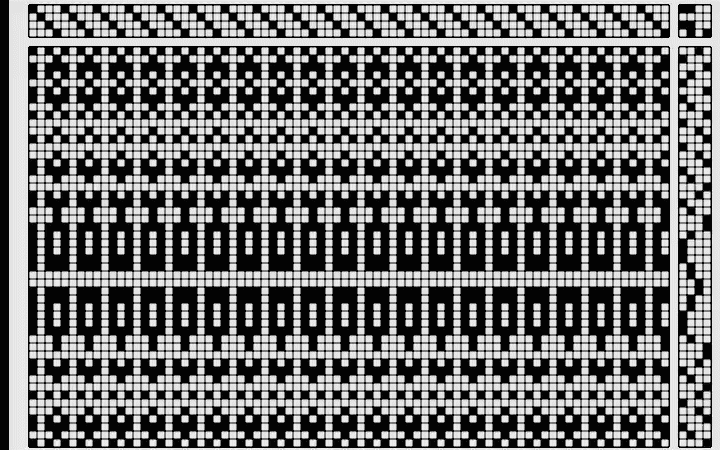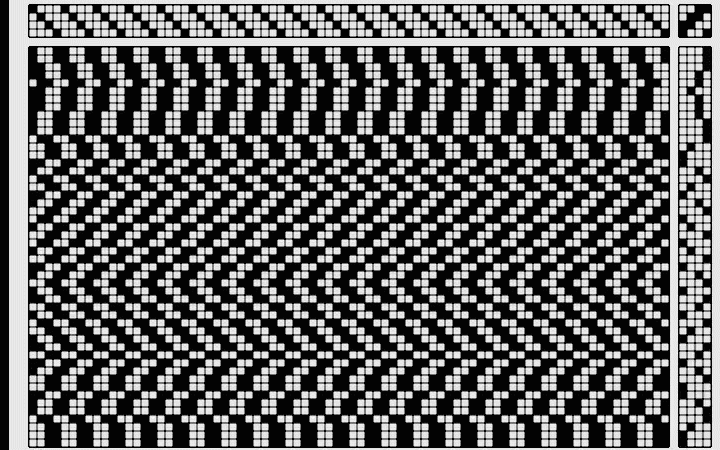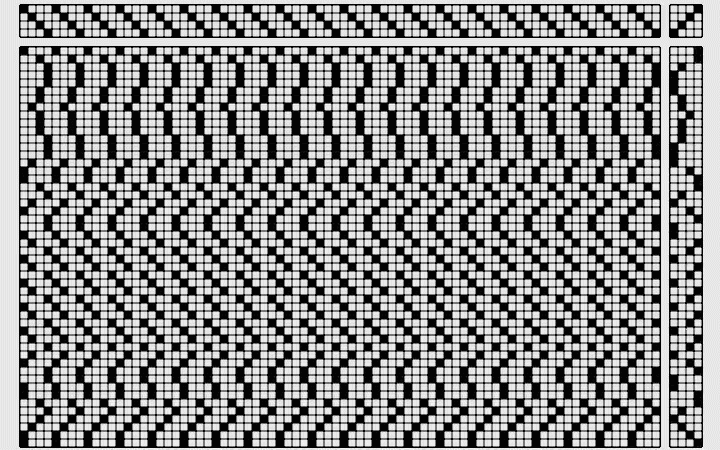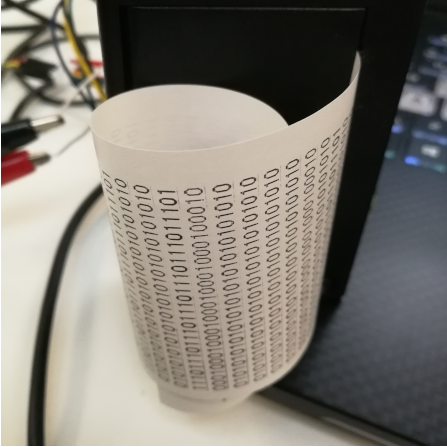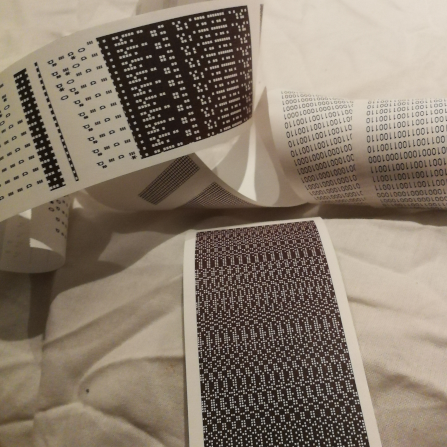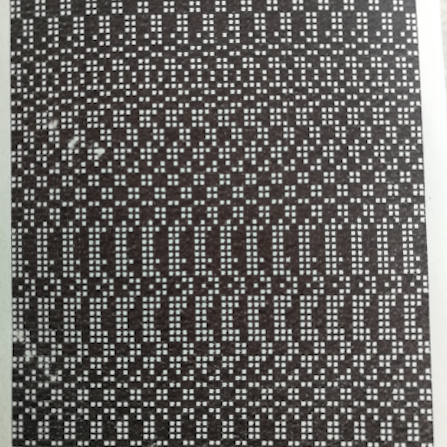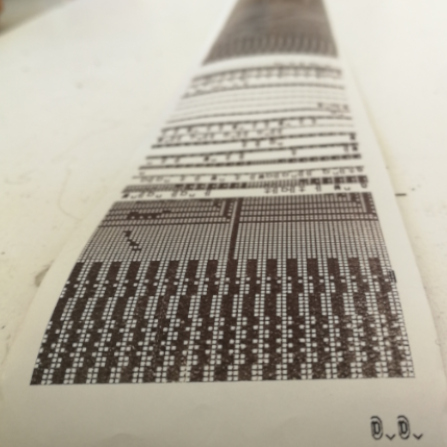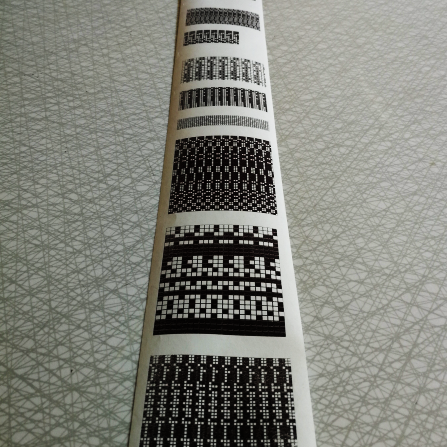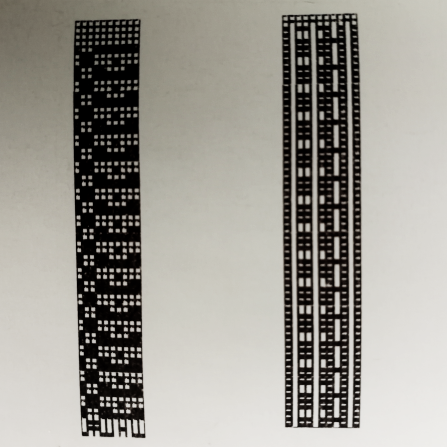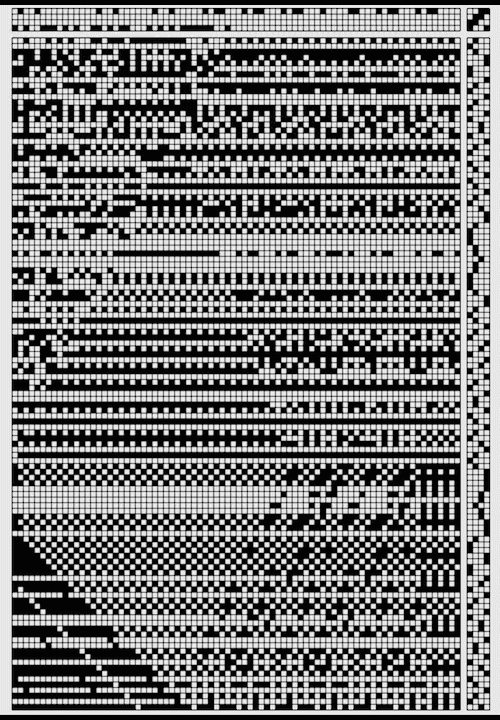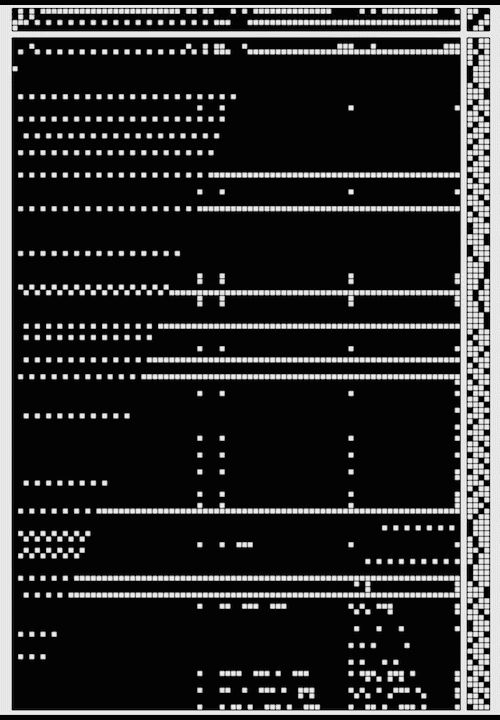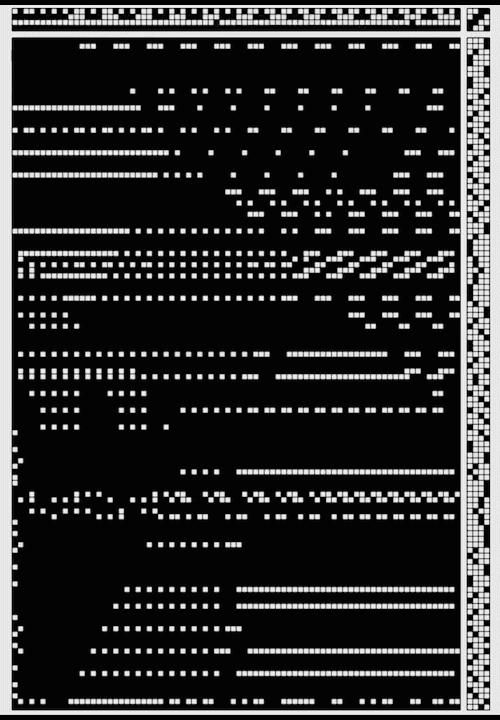Weaving Drafts at the Edge of the Abyss
built by: Jakob Jennerholm Hammar


“Nature is mysterious in her work and multiform.” Anni Albers, Designing, 1943
INTRODUCTION
The weaver, printmaker, designer, artist and teacher Anni Albers, active in the Bauhaus school and Black Mountain Collage, described in One Aspect of Art Work (1944) the weaving process as a journey where even though both compass and vision have been set, the destination is still not clear. In every moment the materials are acknowledging the weavers actions and are presenting their limitations and openings to which the weaver in turn have to respond. It is a fluid and dynamic situation where the finalized weave is depending on the weavers encounters with the materials over time. The end result is uncertain and seemingly impossible to foresee in full. Writing in a time and a world broken by war, Albers finds in weaving, and in the arts and crafts, lessons and preparations for how to live, work and create, build and move forward. How to be constructive under constrains, “learn to respond to conditions productively” and to be experimental, imaginative and inventive. Especially in times of crisis.
The act of weaving where a piece of fabric is created by the interlacing of two materials, threads or yarns have in different manners been inspiring ways of thinking about and understanding the world. Weaving as a practice of binding fibers, structuring them into a single cloth, is ancient and sometimes considered one of the first technologies (Ingold, 2010b; Jolie et al., 2011; McLean et al., 2018; Valoma, 2005) with archaeological findings dating as far back as into the Upper Paleolithic Period 25,000-23,000 BCE (Soffer, 2003). Only recently in 2020, evidence of cord making by Neanderthals were found on a piece of flint dating back 40,000 years ago (Hardy et al. 2020). From twisting fibers into weaving on complex looms, through out tens of thousands of years textile technologies have remained within what appears to be almost all human societies and cultures (Kenning, 2015, p. 4). The specific techniques and technologies as well as aesthetic expressions may differ, but the basic structure of textile fabrics seem to be persistent (Albers, 1941). Likewise the use of weaving, spinning and textile fabrication as not only a metaphor, but a way of both understanding and making sense of the world and working with the structure (or fabric) of the universe, can be traced from ancient times up till today.
This project grew out of the same questions to which weaving is, perhaps not providing clear answers but continually inspire and inform. Questions of how to understand time, space, nature and “reality”. Of how to navigate the ceaseless, unpredictable unraveling of the future, the interconnectedness, agency and entanglement of matter, people and environment. In short, how to handle the strangeness of life and the universe, especially in an ever more digital and technologically complex world. These are obviously no easy or even answerable questions. In stead of leaving them completely, this essay and artistic investigations are tiny attempts to think and discuss with and about them through a small set of experiments in digital creation of weaving drafts.
Weaving drafts or notations are sets of instructions and visualizations of patterns to guide the setup and operation of a loom in the weaving process. The drafts say little about the materiality of the final weave, it’s size, structure, shape, texture or colour. Qualities brought fourth in the weaving process by the interaction between weaver, yarn and loom. Even though the pattern is drawn out and explained, there is room for improvisation, intuition, error and external particularities and influences of all kinds. The drafts carry the history, traditions, identities and memories contained within the patterns as well as reflecting the binary and digital nature of weaving in their fields, grids and matrices. They have a liveliness of their own which, in some ways, is what this essay will attempt to explore. Both as in how the drafts relate to weaving, textiles and digital technology as well as what that might add to the way weaving is being used as trope and practice to gain knowledge and understanding of the world.
This essay draws from a wide and perhaps eclectic set of sources. Thoughts and ideas are gathered from the accounts of weavers, draft and code writers, researchers of computation, textiles, technology, art, philosophy, feminist theory, anthropology and history. Artists, explorers, practitioners and thinkers of different fields and of course the weaving drafts themselves.
Among the key authors and thinkers from whom this project seek guidance and a loose theoretical framework is built, concepts and images of a dynamic world in motion, of uncertain and open-ended futures, becomings and emergence are mutual concerns. Philosopher and professor of women’s studies and gender Elizabeth Grosz explores and helps unpacking notions of time, duration, newness, evolution, art and creativity with among others Gilles Deleuze, Darwin and Henri Bergson. Social anthropologist Tim Ingold brings a rich context of relational ontology, animist thought, materiality, distributed agency, and environmental ecology. I do not intend to layer their ideas on top of each other and present them as if they are one and the same (which they are not), even if they sometime stress similar issues which then is allowed to frame the discussions. Anni Albers brings through their own writings and T’ai Smiths work on the weaving theory of Bauhaus (2014) a life of weaving and teachings full of important insights into the weaving process. Understandings of the complex but intrinsic relationship between weaving and digital technology in both theory and practice are brought by, among others, Emma Cocker, Ellen Harlizius-Klück, Alex McLean, Gabriel and Wagmister and many more.
Due to the scope of this work other sources, authors and ideas and their relevance will have to speak for them selves as they are presented throughout the text. With the risk of getting lost in the mazes and murky waters of the weird and wonderful, I hope it will not be to confusing and preferably make some sort of sense in the end. Perchance it will also allow one or two interesting connections to be made. The discussions, readings and experiments here are not able to be as thorough as would be appropriate, and far to many themes and connections have been left out. In stead the aim is to, through looking at weaving drafts and barely touching on a few select themes, naively venture into some of the areas, allowing my self to be carried along in order to pick up some small pieces of advice and tools to help navigate the world.
This essay is written along a series of practical experiments in the artistic creation of digital weaving drafts. Small detours in a continuing work in progress. Programs that may or may not generate weavable drafts and may or may not say something about the themes that are approached. I am not a very experienced weaver, and the work and research is largely based on coding and readings. I try to be humble and wary of this and therefor rely heavily on the writings of Albers and others as an attempt to limit my own uninformed guesses steering the discussions as much as possible. Even though it probably is not very successful. This research is merely some early (and naive) experiments, trials (and errors) in a process with no clear ending. It is an attempt to search for insights in the weaving drafts, tactics and methods to cope, live and create in and with this world.
Background
Methods and procedures
The structure of this essay will be to first build some context by mapping out and discuss some of the current research made in the area, followed by a few words about weaving drafts, what they are and how they wor.
The main part presents four experiments with weaving drafts and pattern making. They are used to loosely frame and inspire discussions about a few of the different concerns presented in the introduction. The topics, which can be narrowed down to time, grids, patterns and navigation will not cover all there is to say by far. Instead these four experiments and their connected themes will act as shafts of a loom. They will lift a particular set of ideas and let thoughts, code and materials pass through and both limit and as well as structure the research. Each part may only show a small set of connections which hopefully, when beaten together, can reveal some kind of interesting patterns, shapes or constellations.
All of the different experiments could be switch around and still be relevant to the topics they are meant to address. They are derived from the same questions as well the same code-base.
Technical details
The works are variations of a software written in C++ with the help of the openframeworks library. Several addons are used such as Patricio Gonzales Vivo’s ofxThermalPrinter, Christopher Bakers ofxPS3EyeGrabber, Kyle and McDonald’s ofxCv. They are used to help with the output to an Adafruit Mini Thermal Printer, the use of a Sony PS3 Camera and for computer vision and interactive elements.
The software is modelled after a four shaft loom and is in different and very simple ways generating more or less weavable drafts. The program is limited to a very scarce set of functionalities. Four grids and either black or white fields representing the setup and similarly two colours which only suggests a lifted or superimposed thread at a certain intersection of the drawdown. This heavily constrain the possible weaving setups and patterns but still, hopefully, clearly illustrate the process.
Contextual review
The research of Olga Soffer (2004), Soffer et al. (2000) and Jolie et al (2011) emphasize the importance of textile technologies through analyzing ancient archaeological findings of fibers and threads. These works redraws previous timelines of the development of material culture and challenge dominant ideas of gender roles, technology and reconstructions of Upper Paleolithic life, culture and ideology. Further important re-alignments of history and tracings of textile culture can found within Valoma (2005), Barber (1994) as well as with Ursula Le Guin (1992). These are ideas findings that bring textiles to the forefront of technological development and of human history and culture.
Ways of thinking with textiles, of seeing, understanding and describing the world and life within it through textile processes even beyond metaphors is an underlying current in this essay. Tim Ingold (2010a; 2010b; 2012; 2017) has written extensively about textiles, materiality, agency, art, creativity, relational ontology and a wide range of other topics through explorations into comparative anthropology and history. Among these topics ideas about material becomings, transformations, forces and flows are presented through a variety of topics, and among them textility. With textile understandings through relational approaches, Lee (2019) uses the image of the textile-sphere as a tool for for exploring the complexities of social interaction, displacement and contemporary spatiality in both physical and virtual spaces. A way of understanding belonging, and awareness with textiles as a threshold between material and immaterial, human and nonhuman.
The deep connections between digital technology, weaving and textiles have been and currently are being explored by researchers, artists, weavers and coders and it is a vibrant intersection full of ever surprising, radical and important new works, revealings, refigurations and realignments. Artists like Robin Kang (https://robinkang.org) is working with not only the shared aesthetic, imageries and concepts of weaving and technology but with the creative and technical possibilities that lies within the hand operated digital Jacquard loom. Kangs work is presented by Mills (2019) as part the continuous experimentation and renewal of hand weaving following pioneers such as Mary Meigs Atwater and Anni Albers, a practice that have not only endured but thrived as a result of technological development.
Sadie Plant (1995) tells the story of the advancements of technology through Ada Lovelace and Babbage’s work with Jacquards loom which along with industrialization and mechanization and later on digitalization transformed society and brought radical social, cultural and economical change, drastically reordering power structures and gender roles. James Essinger (2004) also places the mechanized, punch-card driven loom at the heart of the development of computers while writers like Davis and Davis (2005), Ellen Harlizius-Klück (2017) and McLean et al (201) sees the digital in the very act of weaving it self as binary and algorithmic art. Gabriel and Wagmister (1997) recognizes the digital in the very handling of threads with hands and fingers as they are re-thinking the relationship between traditional weaving and computer technology. They identify a western computer ideology which is heavily related to traditional weaving is excluding traditional and Third World communities. A relationship between indigenous communities that is also explored by Pitman (2018) through the trope of ‘netweaving’.
Different practical research projects have further explored these relationships. Gail Kenning (2015) Marinos Koutsomichalis and Afroditi Psarra (2015) and investigate the creative possibilities within digital technology for craft-based textile activities and weaving. Daniel Baerlecken and Katherin Wright Johnson (2013), using Ingolds approach of the ‘textility of making’, explores generative textile processes and emergent patterns and formations of matter to solve architectural design problems. A likeness between the computational model of Cellular Automata is found by Hokky Situngkir (2013) to resemble traditional weaving patterns. Through a project where this traditional practice meets computer-aided design they make interesting connections and openings.
Between 2014 and 2017, Weaving Codes- Coding Weaves (http://kairotic.org/; McLean et al, 2017) and the wider and very alive Penelope project (https://penelope.hypotheses.org) is exploring the connections to further integrate ancient weaving with science and digital technology. Involved researchers and artists such as Alex McLean, Annapurna Mamidipudi, Ellen Herlizius-Kluck, Emma Cocker, Dave Griffiths and many, many more have been engaging with a wide variety of topics. Areas including for example live coding and ancient Greek weaving and poetry (McLean et al, 2018), the textility of code (Griffiths & McLean, 2017), understanding Inca Quipu knotting (Rohrhuber & Griffiths) are binding together disciplines, arts and practices through code and textiles.
Throughout most of these examples of research into history, weaving, textility, culture and technology, there is a desire and an urge to in different ways, through textiles, rethink the stereotypic thought forms and power structures that lies embedded within the dominant historical, philosophical and scientific writings and culture that follows. To resist and redraw the imageries that have been equally sustaining and reinforced by colonial, patriarchal and economical exploitation and violence, spaces like Alt_Cph: Patterns in Resistance (https://altcph.dk/) becomes important and inspiring junctions for artists and researchers alike.
Weaving drafts
Weaving is fundamentally simple but have the possibility to become infinitely complex. At its very basic, two sets of entwined fibers, yarns or threads are crossed over at right angles into a consistent piece of fabric. A fixed set of lengthwise ordered threads, the warp, is interlaced by an other set of threads know as weft. The manner in which selected warp threads are lifted creates what is called a shed, an opening through which the weft is passed over the remaining warp. Every pass, called pick or shot, is positioned or beaten into the fabric. A loom is a device, frame or structure of varying complexity used to tension and organize the warp and facilitate the weaving process.
The kind of loom which is referenced in the code and drafts of this research is a four shaft or harness loom. The four shafts or harnesses are frames holding a particular set of warp threads in headdles, loops through which the warp is passed and spaced. These shafts is connected to a series of treadles, mechanisms, often foot pedals, which can control and move the different shafts, lifting certain warp threads, creating different sheds and thus allowing a patterned fabric to emerge.
For thousands of years weaving has been done without notation or other direct forms of graphical drafts and instructions. Weaving patterns and techniques have been, and still are passed on not only by the textiles them selves (Herlizius-Klück, 2017, p. 183), but by word of mouth, lineage and in songs and poetry (McLean et al., 2018).
Weaving drafts, also known as notation or “diagrams of constructions” by Albers (Smith, 2014, p. 149) are a fairly new addition in the world of weaving. Among the earliest manuscripts containing weaving drafts are one by Thomas Lins, a weaver in Tyrolen dated to 1658 and a sample book from Nuremberg dated to 1693 (Herlizius-Klück, 2017, p. 183). The drafts are a set of instructions, likened to a code or musical scores (Smith, 2014, p. 149). They are describing the setup of a loom and the way to handle or operate it to generate a suggested and visualized structure and pattern. They are, as identified by Smith through Albers, “something like an image of practice” (p. 149) that represents the medium, the “in-between”, not a final weave of which it has a limited resemblance. Out of one draft many widely different results may, and perhaps necessarily will, be achieved.
A shaft or harness loom draft usually have four different sections. Three of them represents the setup and handling of the loom while the fourth, the largest section called the drawdown, is representing the output pattern. The positions of each part may vary, but they are generally read out and downwards from the intersection created between them. The large top section, called the threading, is illustrating how the warp threads (running vertically) are connected to the different shafts or harnesses, each represented by a horizontally row in the grid. The smaller top section, the tie-up, is illustrating how the treadles are attached to the shafts. Every column illustrates a treadle which is then connected to one or several shafts. The vertical section next to the drawdown is called the treadling and shows the order or procedure of how to activate the treadles with each pick. All in all it is almost a small static program of how to setup and run the loom to get a desired pattern. Every row of the drawdown is generated by one or more treadles being activated, shown in horizontal correspondence.
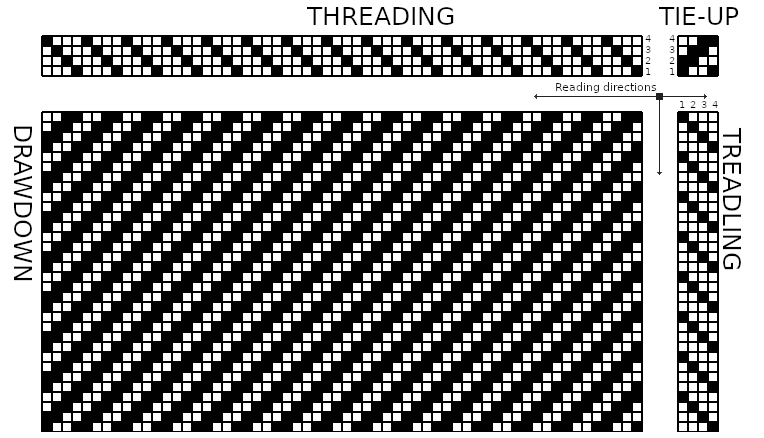

[scheme of a weaving draft, adapted from https://joyofweaving.com/articles/how-to-read-a-weaving-draft/]
THE WORK
TIME
Along with researching drafts and general readings, an important part for exploring the innards of the drafts as well as guiding the project was to build a weaving draft generator. The structure of the code became modeled after a loom and the process of weaving. The first attempts was in the reproduction of simple weaving patterns like plain weave and twill. With the help of mathematical functions, pseudo-random generators and Perlin Noise, different ways of setting up the threading, tie-up and updating the treadling became ways of exploring draft writing and pattern making.
[Screen shots of early draft experiments]
The temporal aspects became evident in both thinking with and coding the drafts. Every opening of a shed and passing of the weft creates a certain arrangement, at first hidden from view and then passed into the larger context of the drawdown. While drafts are usually based on repetitions, on looped sequences that are iterated to produce certain patterns over the length of a weave, the following drafts is an attempt to capture the continuous movement of the weaving process. The drafts became animated in a never ending treadling, picking and beating. Every new row gets integrated into the unfolding pattern.
[Example GIFs of the animated drafts]
Weaving is for Albers a process, a continuous emergence of form conditioned by the weavers encounter with the tools and material in every passing moment. The “limitations and potentialities” (Albers quoted by Smith, 2014) of the fibers and the yarn, their “subtleties” and movements, is ever changing and demanding new responses and actions. A continual flux and variation of matter that have been addressed by authors and artists (among others) in many different ways. It has been thought of as, likened to and explained through a variety of concepts, metaphors, symbols and images. One among them is how Ingold in Rethinking the Animate, Re-Animating Thought (2006) describes the world as being in “continuous birth”. No moment is the same as the previous, the world is in movement and constant transformation. It is explained through becomings, of “things becoming things, and of the world becoming a world”, as Ingold writes referring Merleau-Ponty (Ingold, 2006, p. 12).
As of the introduction of Darwins evolutionary ideas, life Grosz (2008) suggests, can be understood as dynamic process of collective change. It is the “fundamental becoming”, “Life is a movement of temporal fanning, elaboration and emerging complexity, always directed by the forward push of time” (Grosz, 2005, p. 37) (Grosz, 2005, p. 37). The boundary between “life” and “non-life” is not all that clear though (Grosz, 1998, p. 45). Regardless of where we draw the line, both Grosz and Ingold address the need of attributing a sense of becoming to the non-human and the non-organic (Grosz, 1998, p. 53; Ingold, 2006/2010a). The whole world is in movement. It is not merely giving a sense of agency and direction to matter, but to expand and elaborate the very notion of agency and action.
The world or nature, is understood by Grosz (2008) as dynamic forces. It is the “forces of the earth”, of “space, time and materiality” and the “cosmological forces that we can understand as chaos, material and organic indeterminacy” (Grosz, 2008, p. 2). This chaotic universe is not an “absolute disorder” but a “plethora of orders, forms, wills - forces that cannot be distinguished or differentiated from each other” (Grosz, 2008, p. 5). It is as inconclusive, unpredictable, open-ended and full of potentiality as it is overwhelming, but in different ways we can extract something more or less consistent from it to live, create, act and interact with and in it. The force of time is in the immediacy of the present and the unraveling of the future, just as matter, in motion.
Time, writes Grosz (2005, p. 3) stretches itself, as recognized by Bergson, so that it can be perceived as a continuity. As it having the three divisions of a past, present and future. To measure time, to divide it is for Bergson to confuse it with its spacial representation. Time instead, they suggest, is the split between only two temporal movements or trajectories, one oriented towards the future, and one towards the past. These directions, of which one is “actual” and the other “virtual” or “one which has effects, the other which joins and adds to the past” (Grosz, 2005, p. 103), are both real. The present and the entirety of the past is created and “occur” simultaneously. In Bergson’s explorations of “inner life” and consciousness in An Introduction to Metaphysics (2012) they write that one is continually followed by the past as “it swells incessantly with the present it picks up on its way”. It is within the concept of duration, which is described as the “synthesis” of a multiplicity and a unity, of multiple successive states of consciousness or moments which are bound together by a unity, that the mobility and incompleteness of time is shown. Duration is “continually in the making.” (Bergson 2012). “Not everything is presented at once” (Grosz, 2005, p. 106) It is at once an “advancing movement” and “expanding states” or “variety of qualities, continuity of progress, and unity of direction” (Bergson, 2012). It is a continual flow of moments, not one identical of another as every moment contains the memory of the previous. And “consciousness”, they write, “means memory”.
Weaving is perhaps a way to think about duration. The continuous expansion of the fabric and the pattern through the addition of new individual sections that becomes a part of the whole as simultaneously multiple states and a unity. The animated drafts change and evolve with every update. But the limitations of the drafts and the given dimensions cannot contain all of the past history, all of its memories. In stead with every update, as a new row is added, the oldest one gets pushed out of the grid. The focus is on the fluidity, the transformation and change of the pattern more than constant growth and expansion. The perpetual flux of a process in movement.
Memory is what Grosz (2008) and Bergson propose enables life, creativity and evolution. Memory is the precondition of perception, just as the past is a precondition of the present which is “the culmination of the past, its latest layering” (Grosz, 2005, p. 110). It links to, influence and inform the present. But the present is oriented towards the future as a form of “impending action” (Grosz, 2005, p. 102). Duration is the “threshold” of the interaction between perception and action. It is the ceaseless movement forward. It relates back to Ingolds notion of continuous birth, to a world that “is not pre-ordained but incipient, forever on the verge of the actual” where one is “continually present as witness to that moment, always moving like the crest of a wave at which the world is about to disclose itself for what it is” (Ingold, 2006, p. 12). The future constantly re-aligns and overwrites the present (Grosz, 2005, 36), and it is constantly unraveling and revealing it self. It is for Ingold, Grosz and Bergson indeterminate, emergent, open-ended and continually unfolding.
When the future is understood as uncertain and unpredictable and we position progress on either “the edge of an abyss” (Grosz, 1998, p. 37) or the crest of a wave. How can we then approach it without anxiety, panic or even hopelessness? For Grosz it let’s us break with both the notions of rigid determinism and free will. It is through emergence which is “neither free nor determined, but rather both constrained and undecidable” (Grosz, 1998, p. 40) we can start understanding these processes. It may be humbling, but it does not render us helpless in front of the unknown. Even though the “world goes its own way” (Ingold, 2006, p. 18), the openness of the world can bring a sense of astonishment and wonder. While it may call for a resistance of the need to predict or to “extrapolate trends of the present into the future” (Grosz, 2005, p. 2) and an acceptance of the indeterminate emergence of the new, it is quite the opposite of inviting passivity. It could make us more involved, more creative and more effective in our life, workings and politics. What Grosz sees as a “politics of surprise” that can bring more focus on the process than results. Or as Ingold describes as a way of reconnecting “knowing” with “being” and “thought with life” and a way of responding at every moment “to the flux of the world with care, judgement and sensitivity” (Ingold, 2006, p. 19). As with Albers (1944), what weaving and artistic creation can teach us is the process of creating it self. To learn to trust our intuition, dare to take action, make choices and be responsible for the very same. To find courage to venture into the unknown.
Although the treadling and drawdown of these experimental drafts are in motion, the threading and tie-up remain still so that at any given moment the update can be frozen into a functional draft ready to be woven with. The fixed or stable states of the warp are the material conditions needed for the drafts to be helpful in a certain way. The drafts can be used as tracings of possible paths, as loosely sketched maps to bring on that journey into the unknown of the weaving process that Albers writes about. That plunge into the weirdness of the future where we are allowed to be creative together with the unruly forces of the world. The drafts are tools that help to perceive and to act the change and renewal of a weave in the making, not to predict.
GRIDS
After the first set of drafting operations a second approach was pursued. It is foundationally very similar in it’s codebase and procedures of generating drafts but the output and artifacts created are translated into a new form. It is an experiment in suspending the continual flow of the previous ones. A way to try and think about them in a different light. To draw the never ending fluctuations into a structure, arresting them onto pieces of paper that changes the manner in which they are experienced.
By using a thermal printer each row of the draw down gets burnt into paper. The drawdown is no longer just a flood of one dimensional arrays of black and white squares that quickly flickers by and passes beyond the edge of a screen. They become something tangible and maybe even consistent. Lingering and lagging trails of memories that are almost like freeze-dried moments of the previously rapid succession of pixelated rows. It is also a way of reflecting on the digital nature of both the weaving and the drafts. The low speed of the printing process demands a slowing down the update rate of the software. It interrupts the animation and makes the digital stuttering quantization and sampling of the immediate fluidity of the world evident.
[Photos of printed draft]
The weaving drafts are represented as grids, rectangle arrays of ones and zeros, a collection of instructions resulting in a drawn out matrix of patterns. When woven, the warps of the weave are suspended on a loom, a frame-like structure (Smillie, 1991, p. 43). The frame does not only provide the stability that is needed in the act of weaving or the skeletal structure in which the weave materialize, it also holds the data presented in the drafts. It is a container that like how Le Guin describes the carrier bag stopping the food from escaping and opening up for all kinds new possibilities (Le Guin, 1989, p. 150). The grid or the frame holds, carries and opens up new ways of seeing, thinking and experiencing. It organizes and arranges patterns and fibers alike. Creating figurations which are presented in the draft or woven into the weave it self and hopefully maintained after it’s been cut down from the loom.
Framing can perhaps be understood as a way of anchoring and at the same time suspending and detaching something so that it can be experienced. The frame, writes Grosz (2008), becomes a way of engaging with a chaotic reality, with the fluctuating stream of cosmic forces and the complexity and possibilities of the virtual without being completely overwhelmed (2008, p. 28). It is made possible by creating a space to contain pieces of it “through the laying down of a grid or order that entraps chaotic shards, chaoid states, to arrest or slow them into a space and a time, a structure and a form were they can affect and be affected by bodies” (Grosz, 2008, p. 13). The grid or the frame is a mean to try to grasp and dwell on what is ever moving and changing, at least just enough to be able to in some way relate and interact with it. It creates a structure where matter can be transformed and intellectually known, a knowledge that increase the possibility of action (Grosz, 2005, p. 139). It is a relative knowledge differentiated by Bergson from one that is absolute as a form of “intellectual sympathy” or “intuition” (Bergson, 1912, p. 7). Intuition is instead closer to an involuntary “deep-realisation” or a Deleuzian “fundamental encounter” that can “only be sensed” (McMillan, 2002, p.186). It is a way of knowing in an experiential way, of sensing as a result of an encounter with that which is inexpressible, that which is beyond the frame.
These printed patterns are very small reflections of the notions of “slowing down” and “trapping”. A vague emulation of a weave where fibers and forces are held, interlocked and compressed, “framed” into a unit or a whole.
If the frame is a construct where things are contained, the grid can perhaps be understood as where things are arranged and organized. Kraus (1979) describes the modernist use of grids in art as a “flattened, unnatural, unreal coordinate system”. It does not contain a full representation of the totality of reality. It relates to how Le Guin (2018, p. 94) writes that with an artwork, the artist “make a particularly skillful selection of fragments of cosmos, unusually useful and entertaining bits chosen and arranged to give an illusion of coherence and duration amidst the uncontrollable streaming of events”. This, when understood through Le Guins writings of the reality of the imaginative (or a non capitalist creativity) in for example The Operating Instructions (2018), could be helpful to discuss the grid as a way of interacting with the world. When imagination is real (very real) and seen as a fundamental way of thinking and of understanding and affecting the world, the unreality of the grid does not render it useless but could enable even more engagement and interaction with the world or the “chaotic indeterminacy of the real” (Grosz, 2008, p 8). Weather it is through art, philosophy or science, all ways of framing in their own particular manners, they cut out and organize a piece of the world as to be able extract something (temporarily) consistent.
Grosz writes (backed up by an agreement between Deleuze and Derrida) that the construction of the frame is the first gesture of art (Grosz, 2008, p. 10). It separates, cuts and creates an inside and an outside which makes possible an organization of matter and allowing it to “become expressive”, to generate and intensify sensations and to “resonate and become more than itself” (Grosz, 2008, p. 4, p. 6). It is the creation of territories, spaces where qualities are unleashed and sensations arise and are put into play (Grosz, 2008, p. 12). The structure given by the loom or by the draft does not only have the possibility to hold, it is the structure needed for a weave or a pattern to be created.
The matrix, the grid and the frame are all related yet different. The loom, the weave and the draft can perhaps be considered to be all of them at once. The frame contains and the grid orders and gives structure. The matrix on the other hand creates. The matrix, a “more contemporary manifestation of the grid” as described by Whitney (2010, p 1.), is an embedding structure from where things originates, emerges and take form. It transforms the grid into a network or a web which “produces an object that is dependent on links and connections” (Whitney, 2010, p. 3). It parallels with digital technology and natural systems alike. The matrix, like the grid, reveals connections and relations, it “makes the invisible visible” (Whitney, 2010, p. 2). Kraus writes that its orders being of “pure relationship” (1979, p. 51). It maps out, coordinate and redirect forces and flows in and of the world, in and of the weave.
The draft, the loom and the weave are where patterns and fabrics emerge. And with them all the networks, relations, differences and movements they consist of. The coiled up printed pieces of paper of the prints made here, when unrolled or “unfurled and extended like scrolls” as Gabriel and Wagmister writes of traditional weaving patterns, carries and illustrates a sense of connection, of linkage and vast networks stretching out in space and time. Perhaps it relates to and possibly echos Bergson ideas of the continual picking and rolling up of the present into memories. The persistent integration and presence of the past, ordered and conceived within its boundaries.
The individual threads when woven together creates a fabric or cloth, an unbroken surface. The surface has a characteristic texture or complexion made up by and perceived through the difference and variation in it’s material composition (Ingold, 2017, p. 102). The surface is where one can meet with the materials and experience the world. Lee (2019) identifies a way of understanding surfaces that is not made out of the opposition between an inside and an outside or immaterial and material. In citing Küchler (2008) it is described as being a “complementary relation that thrives on transformation rather than distinction” (Lee, 2019, p. 4). The drafts may only so slightly resemble a woven fabric, and maybe even less it’s constitutive quality as a surface. But the grids and matrices of the notation is where “three-dimensional weaves are born out of flat geometric code” (Smith, 2018, p 151). The drafts contain within them a promise and anticipation of what they can help create.
Even if the drafts represents a proposed material structure, Smith writes, they do so in an abstract way by illustrating and describing practice, they are “at once semi-symbolic and semi-iconic” (Smith, 2014, p. 149). They are like downsampled pixelated spectral renderings of a woven surface presented together with the keys and codes to the process. They do of course have a texture of their own in their analog (printed or drawn) and digital form. And as a surface they are perhaps not telling a different as much as a more condensed story then that of a woven cloth. With a piece of fabric, the structure and texture is the result of an interplay and physical differences between the warp and the weft. These “ordered system of difference” (Ingold, 2010b, p. 28), these lines on a fabric are the result of a complex figuration of material qualities embedded within the texture created by the coloured threads and fibres. Even if not coloured, patterns still become visible through the textures, and when these structural differences are combined with colour distributions, fabrics “appears like a wonder to see” (Harlizius-Klück & Fanfani, 2016, p.72). The drafts, while complex in their own right, are hinting at these material structures in their contrasting fields as the intersection of threads. They are binary markings in a geometric “code-as-image” (Smith, 2014, p. 149) within framed operations. The drafts can perhaps be understood as threshold visions within a grid of interconnected lines, illustrations of algorithmic procedures or a process solved and coagulated into patterns.
PATTERNS
Pattern thinking and pattern making are a are part of all of these experiments and this particular iteration is not as much concerned with constructing useful, weavable drafts as it is with ways of thinking about the wider topics of the research. It binds together the ideas of time, frames and patterns, of relational meshworks and collective, emergent transformations and becomings.
The experiment incorporates what is called cellular automata or CA, systems of iterative arrays common in computer science, mathematics, complexity theory, biology, generative art and a variety of fields of art and science. It is a model of computation where the (in this case) on/off states of a number of cells are calculated depending on their immediate neighbours according to a set of rules. With every iteration, the states of the cells are updated into either the same or switched to a new state.
In this setup, every shaft of the loom is containing a one dimensional or elementary CA system. These systems are famously mapped out by computer scientist Stephen Wolfram and used to simulate and think about much the same questions that are approached here. A CA although concerning calculations of input and output by transformational rules that can appear very simple, have the possibility to produce “irreducibly complex behavior” (Wolfram, 2015). When stacked, these one dimensional arrays can create patterns of seemingly orderly, random, repetitive or emergent qualities. These patterns have very interesting similarities with patterns found in natural structures such as seashells and also in man made objects as for example traditional Indonesian artisan and weaving design as presented by Situngkir (2013). And as they are often portrayed in grids of black and white squares, they also echo the aesthetics of weaving drafts. A relevant and interesting connection is how Grosz describes research into cellular automata, under the umbrella of artificial life, as exploration into the idea of "direction without destination, movement without prediction" (Grosz, 1998, p. 41). The use of CA here could be a way of delving into this particular intersection between weaving, culture, tradition, nature and consciousness. Of thinking about emergence and of change, about time and duration, and about patterns, connections and relations.
The use of four combined independent CA systems and (pseudo)randomized rules this is not a particularly useful study of the possibilities of CA. What they can bring is perhaps a feeling of ever emerging complexities and patterns in time, shallowly and shamelessly illustrating and relating to Grosz (2005) reading of Darwin and Ingolds world in the making among others. When the draw down is updated, so are the CA and a new shed is created in the simulated weave and new figurations and patterns appear within the drafts.
[Example GIFs of patterns drawn with Cellular Automata]
The patterns created are structures in time. As “particular gathering or interweaving of materials in movement” (Ingold, 2010a, 96) and like Bergsons conciousness they are paradoxically a multiplicity and a unity. With very new row of the draft or pick of the weave the pattern is not revealed as something already predetermined (and hidden from view) but in every beat or update the pattern is re-aligning it self, continuously unfolding. Emergent, constrained and undecidable. As the patterns are drawn, they grow into what might be understood as self contained living frames, differentiated and separated. A creative and revealing matrix or matrices within the borders of the loom or the draft.
An understanding of what patterns might be communicating is perhaps found within Whitney’s (2010) observation of matrices as hints of “what we cannot see and” and the “many possibilities of what we cannot see or experience in many overlapping dimensions” (2010, p. 2). They reveal something more than just their innards, more than the individual reduced parts. Seeing patterns is then not only a way of monitoring a progression of stacked pieces or arrays of data but of seeing living networks of movement, workings and relations. They are non-linear. And they are extending beyond being a collection of separate nodes or points, or even their connections (Ingold, 2010a, p. 96). It is thought of here with Deleuze and Guattari through McMillan as the “priority of the ‘between’” and as “transversal relations” (McMillan, 2018, p. 189). In that sense the patterns of the drafts as a group of individual black boxes in the grids are experienced as trajectories and currents of communication flowing between and throughout them, “slowed down” as they are framed and distinguished by either color or material structure.
When encountering a pattern, especially in weaving, one is confronted with a specific figuration formed by its materials as well as social and cultural context. Valoma describes the mathematical principles and arrangements of fibers as having developed into “more than a technology”. It became an aesthetic tradition and “geometric sensibility” not only bound to textiles but used within “nearly every other medium, in nearly every culture” (Valoma, 2005). These patterns which are conditioned by the practice of weaving are anchoring a process, a history, identities and traditions within their grids and matrices.
The patterns are telling us about these processes and the knotted relationships between them. A connectedness and linkage, Gabriel and Wagmister writes, that is open-ended and “extends the boundaries of the individual” (1997, p. 337). The patterns, they continue, found within traditional Latin American, Indian, and African weavings are not fixed but “belong to yet larger networks of memory and experience” (Gabriel & Wagmister, 1997, p. 337). The patterns tells, as seen above, not one story but many stories. It links to Lees “Textile-Sphere” as a relational understanding of lived surfaces, the focused but subverted boundaries and margins between self and other, animate and inanimate, ones body and nearby environment (2019, p. 6). The patterns are particular cultural expressions, fabrics of “memory, of communal identities and their connection to the rest of humanity” (Gabriel & Wagmister, 1997, p. 337).
The individual, just as an intersection of a weave or a point in a draft is continually moving, acting and reacting, involved in the movements of others, the world and the environment. An environment not seen here as an outside or a surrounding but a “zone of entanglement” (Ingold, 2007). The organism and the environment is not separated but enmeshed. It is understood as a “web of lines of growth” (Ingold, 2007, p. 13), likened to a fungal mycelium or Deleuze and Guattari’s rhizome. The environment is not an outlining but understood as the “domain of entanglement” (Ingold, 2007, p. 13). A pattern in a weave is perhaps reflecting such a domain and a way of understanding and thinking with concepts of dynamic processes and collective becomings.
The contrast of the individual figuration of a shed in the weaving process which forms a specific row in the draw down with the whole pattern that is reborn and transformed with each generation. The draft experiment presented here are a small drift into the idea of distributed relational networks. Each cell is not to be considered alone, in relation to the cells of the row or even the whole draft. The pattern is stretching out in all directions, creating, illustrating and revealing sub-patterns, repetitions within repetitions and movements within movement. Complexities, flows, strokes and currents of varying sizes, velocities and direction resonating with all the tensions and underlying relations of what lies between, within and beyond the drafts.
NAVIGATION
The third and final experiment takes the form of a proposed installation. It is a small venture into what could be an experiential and embodied way of creating or generating patterns. A way interacting with the unfolding of the drawdown. A situation where the participators with their bodily movements are continuously influencing and positioning the treadling of a draft where patterns are generated and constantly updated in real-time and shown on a screen. It is incorporating elements of all of the previous discussions, as an attempt to bring them together into an open ended experiment and exploration. A search for what weaving and drafting can teach us of how to maneuver the never ending movement and transformation of an interconnected world.
A webcam pointed outwards is reading the room in front of the screen. Through optical flow, a particular way of calculating patterns of apparent movement, the software is translating the motion taking place into an influence upon the treadling which in turn generates a new row in the drawdown with every update. The update is always happening, but when a motion is detected the update speed is increasing making the program more responsive to the movements of the participant. But the patterns created are not solely dependent of this interaction but is relying on the movement and positions in relation to the state of the threading and tie-up which can be configured in different ways. Hopefully it is resulting in a process where one is needed to explore the unfolding of patterns by engaging with and reacting to the inclinations of the different parts of the draft. The use of motion detection as a trigger to faster update explores this in a certain way, focusing on the participation and responsiveness more than a relentless temporal flow as seen in the first experiment. A way of asking different questions, or honing in on slightly different aspects and notions. As with previous examples, the different parts of the update can be paused. A particular warp setup can then be frozen and the patterns it may yield can be explored and create a more weavable draft.
It ties back to Albers journey into the unknown, and to the question of how to navigate the landscape if the maps and compasses are, if present at all, without much use. The weaving process is not a journey taken alone, it is accompanied and guided by both material and the work process it self. This relation is what this installation is approaching at by place the participant along the path and in the very flow of time and matter.
Albers (1944) explains this mutual voyage, this “interrelation” or “subtle play” (Smith 2018, p. 150) as learning to “listen to the voices: to the yes or no of our material, our tools, our time”. The weavers are perhaps like the practitioners whom Ingold characterize as “wanderers, wayfarers, whose skill lies in their ability to find the grain of the world’s becoming and to follow its course while bending it to their evolving purpose” (Ingold, 2010a, p. 92). It is to consciously following of the “material flow” of Deleuze & Guattari. Encounters with matter in movement which can only be followed, or materials, as described by Ingold (2010a, p. 94). Matter is in constant flux, and a creative or form giving practices such as weaving is the engagement with these motions and transformations. The giving of form, not as imposing form unto matter but as an intervention “in the fields of force and currents of material wherein forms are generated” (Ingold, 2010a, p. 92), is led by the materials themselves.
When matter is given indeterminacy and openness (Grosz, 1998, p. 43) and a sense of becoming and individuation (Grosz, 1998, p. 52), it would no longer be passive, dead and inert, as Ingold writes (2010a, p. 92). A craft and art like weaving become almost communicative and concerned with attentiveness and responsiveness to the materials and flow of forces. Of “reacting to material rather than the execution of a dream” as Albers (1941) writes. Matter and material have properties and demands of their own. The drafts become a “locus of agency” for the weaver as suggested by Atwater (Smith, 2019, p. 119), but also for all the forces and material involved. Not merely as separate agents acting, carrying on their own isolated tasks, but as a “hive of activity” (Ingold, 2010a, p. 96). Agency is in the interaction and movements, in between, as “entwined” and interwoven becomings, energized by the flows and “generative currents” the world (ibid. ). It is way of rethinking agency, agents and even causality. A possible and provoking link back to Grosz’s understanding of forces and how they, with Nietzsche, re-conceptualize subjectivity and the subject it self (see Grosz, 2006, p. 186).
Plant, referring to Margaret Mead, identifies and highlights, much like Albers and Gabriel & Wagmister, the connection between body and process in hand weaving. A process disrupted by the introduction of industrial mechanization (Plant, 1995, 57). Similarly McLean et al. identifies what they call “the goal-driven notion of technological development” (McLean et al., 2018, p.8). They oppose this notion with live coding which they connect with Emma Cockers term kairotic practice. By encouraging the encounter with the flow of force, live coding like weaving opens up to improvisation. It enables a direct and simultaneous link between action and the current process, making and deciding or responding to the “living moment” (MacLean et al., 2018, 8). Perhaps as an attentiveness to the materials in the moment and an understanding of their openings and possibilities.
Understood as a combination of “kairos (opportune timing) and mêtis (wily intelligence)” (Cocker, 2017, p. 126) as a subspecies of the Ancient Greek concept of technē, the focus is on direct response to what is unfolding. A “thinking-in-action” or “thought-in-motion” (Hawhee, 2004, p. 75, quoted by Cocker, 2017, p. 132) or a knowledge of how to navigate the unpredictable through “seeing and seizing the potential of chance, randomness and indeterminacy” (p. 140). A way of working with, around and through the limitations and constrains that present them selves along the way. To recognize them and to direct and “deform” them into new paths and destinations.
The weaving drafts then, if understood as guides, can perhaps create focal points of attention. They lead the perception of the weaver as to where, when and perhaps even how the body needs to be wary or prepared to attune it’s movements in response to to the materials. Not as predictions but as possible crossroads and openings.
The interactive draft and pattern experiment presented here is perhaps stretching and even collapsing the whole idea of what drafts are meant to be and understood as here. But still it draws out some lines of thought connecting them to the very act of weaving as creating with, responding to and navigating the materials as well as an interconnected and emergent world. Every update of the software, every loop and cycle reveals new openings and possibilities as well as perceived boundaries, both which are the wills and forces running through and between each and every part. Perhaps like the “other repetition” of Deleuze and “spiral repetition” of Bennet as referred to by McMillan (2018) in the context of “enchantment”. It is where “things repeat but with a twist” which “makes possible new formations” (Bennet, 2001, p. 39 quoted by McMillan, 2019, p. 190). It is when every cycle or each “turn” of the passing of weft through the shed of a weave, or the drawing of a row of a draft or structure of code, just like a spiral, “enters into a new and distinctive assemblage” (McMillan, 2019, p. 190). An assemblage of which force is the condition (Grosz, 2005, p. 188). The patterns in the drawdown on the screen is ever emerging, taking on new forms with every update. The threading and tie-up is either fixed or in other ways beyond the direct control of the interactant but the movements and positioning continuously intervene and direct the outcome.
CONCLUSION
These experiments, readings and discussions have been following a very narrow, meandering and unstable trail, bringing the weaving drafts out on deep (perhaps too deep) waters. The inquiry into the nature of the drafts as well as the wider questions asked can conceivably be seen as both complicating and complementing each other. The code written and artefacts created have been exploring yet reaching beyond the drafts them selves into the underlying processes which they portray and take part of, allowing a perhaps wider but much shallower investigation. Similarly the overarching thematic structure and winding path through time, grids, patterns and navigation left out, cut of, and brushed over several important and interesting concepts but made possible to reveal other connections and draw different threads betwen them.
Throughout these workings and readings, a focus on process more than results has been linking each step with along the way. As an image of process and a creative and experimental technology, the weaving drafts can perhaps reflect and express the shared concepts of duration, movement, transformation, becoming and relationality found within the writings and thoughts presented. As a way of anchoring and interacting with the world, the drafts becomes a very pronounced and applied way of thinking of the uncertainty and continuous unfolding of the future. Of how the present merges with the past in every passing moment, not to get swept away but to be integrated into our collective and individual memory, shaping how we perceive and act upon the next one. And of how we create together with everything and everyone around us as we are swept along. navigate and direct the flows and forces of nature.
The unpredictability and inconclusiveness of the world of Albers, Cocker, Grosz and Ingold gives us the possibility to change and to progress. That indeterminacy and flux which limits our sight and control is also where the potentiality to create and build resides. The very practical advice of Cocker and insights of Albers together with Grosz’s embrace of the new and Ingolds re-animating of the world all contribute with important ways of thinking with and beyond the drafts.
By standing on that perpetual crest of a wave, or peering down into the Abyss, the unknown depths or fathomless void of the future and of what lies beyond the frame, caught up in the worlds unfolding and outwards spiraling, one is never fully in control of what is to come. Although one is always participating and co-creating, responding and maneuvering that ceaseless flow forward.
There are several directions to where this work can set out. The realm of the imagination is one path I wish to take. And so is following up on Bergsons concepts of the virtual and actual which was mentioned far to briefly. As is the area of emergence, of ways to think beyond free will and determinism as well as the wider revealing and creative capacities of pattern seeing and making.
These small experiments with the weaving drafts became a place where I found much inspiration. It led me to find a vibrant and dynamic field of artistic, practical and theoretical explorations where new provoking and exciting works and insights are made within a rich and diverse community of which far to many where left out. My intention is to continue to further work with weaving and drafting, delving deeper into currents and connections between the digital and the analogue.
ANNOTATED BIBLIOGRAPHY
Gabriel, Teshome H., and Fabian Wagmister. “Notes on Weavin’ Digital: T(h)Inkers at the Loom.” Social Identities 3, no. 3 (October 1997): 333–44.
Gabril and Wagmister explores the similarities and what they describe as real and vital connections (structural, aesthetic and spiritual) between traditional weaving and digital technologies. They are re-thinking these relationships with the intention of open up computer technology and re-connecting it to its heritage in traditional cultures. The text brings important perspectives on these relations, on historical connections, ways of facing and challenging the excluding and homogenising forces of digital technology through transforming them into a diverse and inclusive media.
McLean, Fanfani, and Harlizius-Klück. “Cyclic Patterns of Movement across Weaving, Epiplokē and Live Coding.” Dancecult: Journal of Electronic Dance Music Culture 10, no. 1 (2018).
The authors explore the connections between live coding, weaving and ancient Greek poetry. Their understanding of weaving as both a metaphor and ancient digital artform within the concept of kairotic practices introduces relevant insights into the nature of the weaving as well as coding process.
Smith, T’ai. Bauhaus Weaving Theory: From Feminine Craft to Mode of Design. University of Minnesota Press, 2014.
Smith’s book examines the practices, works ideas and writings of the Bauhaus weavers. The texts contributes to several parts of the research with the reworking of history, ideas and discourses of craft, medium, material and gender roles as well as further understandings of words and deeds of Anni Albers. By reflecting on several of the same questions asked here as well as the writings of Albers the book gave important perspectives on weaving, drafting and much more.
REFERENCES
Albers, Anni. “Designing.” Craft Horizons, no. 46:4. (1943). https://albersfoundation.org/teaching/anni-albers/texts/#slide1.
———. “Handweaving Today: Textile Work at Black Mountain College.” The Weaver, no. 6:1 (1941). https://albersfoundation.org/teaching/anni-albers/texts/#slide5.
———. “One Aspect of Art Work, We Need the Crafts for Their Contact with Material.” Design, no. 46:4. (1944). https://albersfoundation.org/teaching/anni-albers/texts/#slide1.
———. “The Pliable Plane: Textiles in Architecture.” Craft Horizons, no. 18 (1958). https://albersfoundation.org/teaching/anni-albers/texts/#slide5.
Baerlecken, Daniel, and Katherine Wright Johnson. “Nominalized Matter: Generative Textiles Procedures.” In Proceedings of the XVII Conference of the Iberoamerican Society of Digital Graphics - SIGraDi: Knowledge-Based Design, 515–19. Valparaiso, Chile: Editora Edgard Blücher, 2013. https://doi.org/10.5151/despro-sigradi2013-0099.
Davis, Martin, and Virginia Davis. “Mistaken Ancestry: The Jacquard and the Computer.” TEXTILE 3, no. 1 (January 2005): 76–87. https://doi.org/10.2752/147597505778052594.
Dietz, Ada K. Algebraic Expressions in Handwoven Textiles. Louisville: Little Loomhouse, 1949. https://www.handweaving.net/document-detail/2964/algebraic-expressions-in-handwoven-textiles-dietz-ada-k-little-loomhouse.
Essinger, James. Jacquard’s Web : How a Hand-Loom Led to the Birth of the Information Age. Oxford: Oxford University Press, 2004.
Gabriel, Teshome H., and Fabian Wagmister. “Notes on Weavin’ Digital: T(h)Inkers at the Loom.” Social Identities 3, no. 3 (October 1997): 333–44. https://doi.org/10.1080/13504639751943.
Griffiths, David, and Alex McLean. “Textility of Code: A Catalogue of Errors.” TEXTILE 15, no. 2 (April 3, 2017): 198–214. https://doi.org/10.1080/14759756.2017.1298308.
Grosz, E. A. CHAOS, TERRITORY, ART Deleuze and the Framing of the Earth. New York: Columbia University Press, 2008.
———. “Thinking the New: Of Futures Yet Unthought.” Symploke 6, no. 1 (1998): 38–55. https://doi.org/10.1353/sym.2005.0074.
———. Time Travels : Feminism, Nature, Power. Next Wave. Durham: Duke University Press, 2005.
Harlizius-Klück, Ellen. “Weaving as Binary Art and the Algebra of Patterns.” TEXTILE 15, no. 2 (April 3, 2017): 176–97. https://doi.org/10.1080/14759756.2017.1298239.
Harlizius-Klück, Ellen, and Fanfani, Giovanni. “(B)Orders in Ancient Weaving and Archaic Greek Poetry.” In SPINNING FATES AND THE SONG OF THE LOOM: The Use of Textiles, Clothing and Cloth Production as Metaphor, Symbol and Narrative Device in Greek and Latin Literature, Vol. 24. ANCIENT TEXTILES SERIES. Oxford: Oxbow Books, 2016.
Ingold, Tim. “Bindings against Boundaries: Entanglements of Life in an Open World.” Environment and Planning A: Economy and Space 40, no. 8 (August 2008): 1796–1810. https://doi.org/10.1068/a40156.
———. “Rethinking the Animate, Re-Animating Thought.” Ethnos 71, no. 1 (March 2006): 9–20. https://doi.org/10.1080/00141840600603111.
———. “Surface Visions.” Theory, Culture & Society 34, no. 7–8 (December 2017): 99–108. https://doi.org/10.1177/0263276417730601.
———. “The Textility of Making.” Cambridge Journal of Economics 34, no. 1 (2010a): 91–102. https://doi.org/10.1093/cje/bep042.
———. “Toward an Ecology of Materials.” Annual Review of Anthropology 41, no. 1 (October 21, 2012): 427–42. https://doi.org/10.1146/annurev-anthro-081309-145920.
———. “Transformations of the Line: Traces, Threads and Surfaces.” TEXTILE 8, no. 1 (2010b): 10–35. https://doi.org/10.2752/175183510X12580391270100.
———. “When ANT Meets SPIDER: Social Theory for Arthropods.” In Material Agency: Towards a Non-Anthropocentric Approach, edited by Carl Knappett and Lambros Malafouris, 209–15. Boston, MA: Springer US, 2008. https://doi.org/10.1007/978-0-387-74711-8_11.
Jolie, Edward A., Thomas F. Lynch, Phil R. Geib, and J. M. Adovasio. “Cordage, Textiles, and the Late Pleistocene Peopling of the Andes.” Current Anthropology 52, no. 2 (April 2011): 285–96. https://doi.org/10.1086/659336.
Kenning, Gail. “Creative Craft-Based Textile Activity in the Age of Digital Systems and Practices.” Leonardo 48, no. 5 (October 2015): 450–56. https://doi.org/10.1162/LEON_a_00907.
Koutsomichalis, Marinos, and Afroditi Psarra. “Computer-Aided Weaving: From Numerical Data to Generative Textiles,” 2015. https://doi.org/10.14236/ewic/eva2015.59.
McLean, Alex, Ellen Harlizius-Klück, and Janis Jefferies. “Introduction: Weaving Codes, Coding Weaves.” TEXTILE 15, no. 2 (April 3, 2017): 118–23. https://doi.org/10.1080/14759756.2017.1298232.
McLean, Fanfani, and Harlizius-Klück. “Cyclic Patterns of Movement across Weaving, Epiplokē and Live Coding.” Dancecult: Journal of Electronic Dance Music Culture 10, no. 1 (2018). https://www.dj.dancecult.net/index.php/dancecult/article/view/1036.
McMillan, Christian. “Jung and Deleuze: Enchanted Openings to the Other: A Philosophical Contribution.” International Journal of Jungian Studies 10, no. 3 (September 2, 2018): 184–98. https://doi.org/10.1080/19409052.2018.1505236.
Mills, Sarah. “The Eternal Renewal of Hand Weaving.” The Journal of Modern Craft 11, no. 2 (May 4, 2018): 117–26. https://doi.org/10.1080/17496772.2018.1493794.
Pitman, Thea. “Warriors and Weavers: The Poetics and Politics of Indigenous Appropriations of New Media Technologies in Latin America.” Modern Languages Open 2018, no. 1 (July 12, 2018): 14. https://doi.org/10.3828/mlo.v0i0.207.
Plant Sadie. “THE FUTURE LOOMS:WEAVING WOMEN ANDCYBERNETICS.” Body & Society, no. 1 (1995): 45–64.
Rohrhuber, Julian, and David Griffiths. “Coding with Knots.” TEXTILE Journal of Cloth and Culture, no. 2: Weaving Codes, Coding Weaves (July 20, 2017): 143–57. https://doi.org/10.5281/zenodo.1098248.
Situngkir, Hokky. “Cellular-Automata and Innovation within Indonesian Traditional Weaving Crafts.” SSRN Electronic Journal, 2013. https://doi.org/10.2139/ssrn.2357389.
Smillie Keith. “The Computer Construction of Weaving Designs.” Toronto, 1997.
Smith, T’ai. Bauhaus Weaving Theory: From Feminine Craft to Mode of Design. University of Minnesota Press, 2014. https://muse.jhu.edu/book/35700.
Soffer, O., J. M. Adovasio, and D. C. Hyland. “The ‘Venus’ Figurines: Textiles, Basketry, Gender, and Status in the Upper Paleolithic.” Current Anthropology 41, no. 4 (August 2000): 511–37. https://doi.org/10.1086/317381.
Soffer, Olga. “Recovering Perishable Technologies through Use Wear on Tools: Preliminary Evidence for Upper Paleolithic Weaving and Net Making.” Current Anthropology 45, no. 3 (June 2004): 407–13. https://doi.org/10.1086/420907.
WEB REFERENCES
“Robin Kang,” Accessed May 1, 2020. https://robinkang.org/.
“The Penelope Project.” Accessed May 1, 2020. https://penelope.hypotheses.org/.
“Weaving Codes – Coding Weaves.” Accessed May 1, 2020. http://kairotic.org/.
CODE REFERENCES
"Optical Flow Test," Adrian Sheerwood, Accessed April 15, 2020. https://aaron-sherwood.com/blog/?p=700
"Elementary Cellular Automata," Tomas de Camino, Accessed, April 1, 2020. https://www.openprocessing.org/sketch/135620
"Nature of Code, Chapter 7. Cellular Automata," Daniel Shiffman, Accessed April 1, 2020. Chapter https://natureofcode.com/book/chapter-7-cellular-automata/
"ofxThermalPrinter", Patricio Gonzalez Vivo. https://github.com/patriciogonzalezvivo/ofxThermalPrinter
"ofxCV", Kyle McDonald. https://github.com/kylemcdonald/ofxCv
"ofxPS3EyeGrabber", Christopher Baker. https://github.com/bakercp/ofxPS3EyeGrabber
LINK TO PROJECT SOURCE CODE
https://github.com/veitkal/wyrdFirstTest






































































